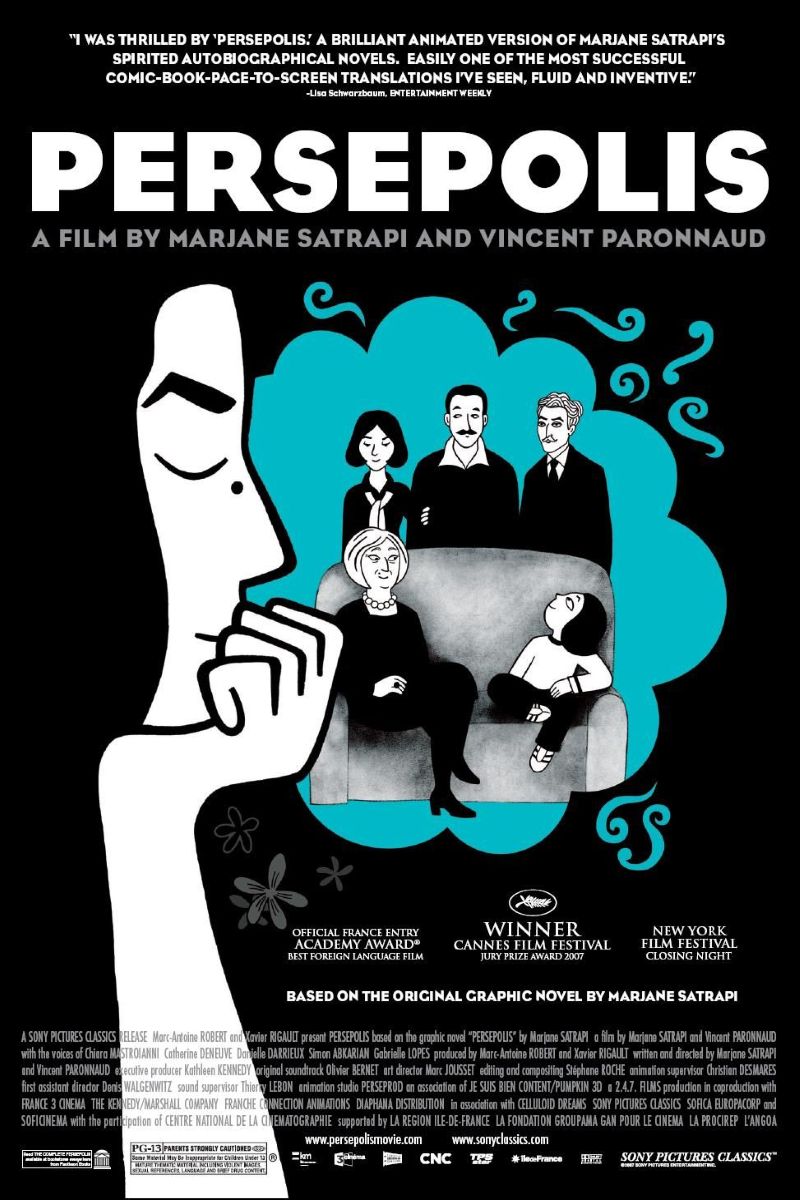
Persepolis
Persepolis
Based on Marjane Satrapi's autobiographical graphic novel, this black-and-white animated film tells the story of an Iranian girl's coming-of-age before and after the Islamic Revolution, profoundly exploring women's survival and resistance under religious totalitarianism.
Cast
Related Topics
🎥 Film Analysis & Review
“Persepolis” stands as a revolutionary animated film that serves not merely as a visual memoir but as a profound indictment of women’s conditions under religious totalitarianism. Through her personal experience, Marjane Satrapi presents a complex and authentic Iran, revealing how women growing up amid political upheaval navigate the tensions between tradition and modernity, religion and secularism, submission and resistance.
Visual Language and Political Commentary
The film’s black-and-white animation style represents more than an aesthetic choice—it carries deep political and philosophical significance. The stark contrast between black and white symbolizes the sharp conflicts between authoritarianism and freedom, repression and expression, tradition and modernity. This minimalist visual language strips away surface decoration to directly address core issues. Simultaneously, the animated medium provides a protective mechanism, allowing creators to express views on sensitive political topics with relative safety.
The monochromatic palette also reflects the binary thinking imposed by totalitarian systems, where complexity and nuance are eliminated in favor of rigid categories of acceptable and unacceptable behavior. This visual choice mirrors the restricted world Marjane inhabits, where women’s lives are reduced to simple dichotomies of moral and immoral, covered and uncovered, obedient and rebellious.
Female Coming-of-Age Under Dual Oppression
Marjane’s growth trajectory perfectly demonstrates women’s struggles under the dual oppression of patriarchy and religious conservatism. From childhood innocence to teenage rebellion to adult exile and eventual return, each stage presents different gender-related challenges. She is forced to wear hijab, forbidden from listening to Western music, and required to follow strict moral codes—all direct forms of religious totalitarian control over women’s bodies and spirits.
The film’s portrayal of pre- and post-revolutionary Iran is particularly striking. While politically authoritarian, pre-revolutionary Iran was relatively open in social and cultural terms, allowing women to choose their clothing freely and participate in social activities. The post-revolutionary religious regime pushed women back into private spheres through strict dress codes, behavioral restrictions, and moral surveillance. This contrast reveals how political change directly impacts women’s quality of life and degree of freedom.
Intergenerational Wisdom and Resistance
Marjane’s grandmother emerges as a particularly significant character, representing the resilience and wisdom traditions of Iranian women. Despite living in an oppressive environment, she maintains dignity and independent spirit, becoming Marjane’s spiritual mentor. Her presence reminds us that women’s resistance spirit doesn’t appear suddenly but has deep historical roots and cultural transmission.
The grandmother’s flower perfume and free speech symbolize how women can maintain inner beauty and strength even in the darkest times. Her advice to “always keep your dignity and be true to yourself” becomes a guiding principle for Marjane’s life. This intergenerational connection emphasizes how feminist consciousness is transmitted through family relationships and personal relationships rather than formal institutions.
Religion as Political Control Mechanism
The film’s critique of the combination of religious and political power is exceptionally sharp. It reveals how religious extremism exploits traditional values to legitimize women’s oppression. The hijab transforms from personal faith expression into a tool of political control, making women’s bodies battlegrounds for ideological struggle. Through Marjane’s conflicts with religious police, the film demonstrates direct confrontation between personal freedom and state power.
The film also explores how religious discourse is manipulated to serve political ends. Religious authorities use selective interpretation of texts to justify restrictions on women while ignoring broader principles of justice and compassion. This analysis reveals how fundamentalism distorts religious traditions to serve patriarchal power structures.
Education as Liberation Strategy
Education occupies a crucial position in the film. Marjane’s parents insist on providing their daughter with quality education, a choice that itself represents resistance to gender discrimination. Education is portrayed as a key pathway to women’s liberation, with knowledge serving as a weapon against ignorance and prejudice. Marjane’s study experience in Austria, while challenging, provides her with comparative perspective, helping her recognize her homeland’s problems more clearly.
The film demonstrates how education enables critical thinking and international perspective essential for recognizing and challenging oppression. Marjane’s exposure to different political systems and cultural values equips her to analyze her own society with greater sophistication and nuance.
Cultural Identity and Exile
The film’s exploration of cultural identity is profound. Marjane’s Western life experience makes her realize that escape cannot solve fundamental problems. She must confront her cultural identity, maintaining connection to her roots while critiquing traditions. This complex emotional experience is shared by many immigrant women, particularly those from traditional societies.
The tension between belonging and alienation creates a unique form of feminist consciousness that transcends national boundaries while remaining grounded in specific cultural experiences. Marjane’s eventual return to Iran represents not submission but a more complex understanding of how to maintain integrity while navigating oppressive systems.
War Through Women’s Eyes
The film’s treatment of war scenes demonstrates the uniqueness of female perspective. Unlike traditional war films, “Persepolis” focuses not on battlefield heroism but on war’s impact on civilians, particularly women and children. Air raid sirens, fear of death, resource shortages—these are presented from women’s and family perspectives, providing more comprehensive and humanized understanding of war.
This approach reveals how women experience political conflict differently from men, emphasizing survival, family protection, and community maintenance rather than conquest or ideology. The film shows how women’s wartime experiences are often invisible in official histories but central to understanding conflict’s human costs.
Music and Cultural Resistance
The film’s musical choices are particularly noteworthy. Western rock music represents not merely entertainment but symbols of freedom and rebellion. Music becomes Marjane’s way of expressing personality and resisting authority, while serving as her bridge to Western culture. When such music is banned, it becomes direct evidence of political oppression.
The underground circulation of Western cultural products demonstrates how cultural resistance operates beneath official surveillance. These seemingly minor acts of defiance represent broader struggles for cultural autonomy and individual expression within totalitarian systems.
International Success and Universal Themes
“Persepolis’s” international success proves the universality of women’s voices. Though set in specific cultural and political environments, its core themes—women’s struggles for freedom and self-realization—resonate across cultures. The film helps global audiences understand Middle Eastern women’s complex realities, countering monolithic stereotypes in Western media.
The film’s reception demonstrates how personal narratives can transcend cultural boundaries to create international solidarity around feminist issues. Marjane’s story becomes representative of broader struggles against patriarchal oppression worldwide.
Political Courage and Artistic Resistance
The film’s political courage cannot be ignored. Under current international political circumstances, criticizing the Iranian regime requires tremendous bravery. Through this work, Satrapi not only speaks for Iranian women but provides strength and inspiration for oppressed women worldwide. Her personal story becomes political statement, proving art’s important role in social transformation.
The decision to maintain critical perspective while avoiding simplistic demonization demonstrates sophisticated political analysis that recognizes complexity within oppressive systems while maintaining clear moral standards.
Animation as Accessible Political Medium
The choice of animation as medium serves multiple functions beyond aesthetic appeal. Animation allows for metaphorical representation of complex political ideas while remaining accessible to diverse audiences including young people. The medium also provides protection for creators addressing sensitive political topics while creating emotional distance that enables audience engagement with difficult subjects.
The film demonstrates how animation can serve serious political purposes while maintaining entertainment value, proving that accessible media forms can carry sophisticated political messages without compromising artistic integrity.
Hope and Resilience in Darkness
Ultimately, “Persepolis” conveys messages of hope and resilience. Despite facing numerous difficulties, women can maintain dignity and dreams. Marjane’s story tells us that true freedom is not merely political but spiritual. Even in the most oppressive environments, individual voice and choice remain important.
The film’s ending, with Marjane walking toward an uncertain but self-determined future, suggests that liberation is an ongoing process rather than a final destination. Her journey represents not just personal growth but the continuing struggle of women worldwide to define themselves on their own terms.
Legacy and Continuing Relevance
“Persepolis” continues to resonate in contemporary discussions about women’s rights, religious freedom, and political oppression. The film’s portrayal of how quickly women’s rights can be reversed serves as warning for societies where gender equality remains fragile. Its emphasis on individual agency within collective struggle provides inspiration for contemporary feminist movements.
The film stands as tribute to all women fighting for freedom and as declaration of hope for the future. It reminds us that even under the most repressive circumstances, the human spirit’s desire for freedom and authentic expression cannot be completely extinguished. Through Marjane’s courage to tell her story, “Persepolis” becomes both historical document and call to action, proving that personal narratives can serve political transformation and that women’s voices, when courageously expressed, have the power to change the world.
🏆 Awards & Recognition
- • Jury Prize at the 60th Cannes Film Festival
- • Golden Globe nomination for Best Foreign Language Film
- • Academy Award nomination for Best Animated Feature
⭐ Ratings & Links
Related Recommendations
讨论区
分享您的想法和观点
加入讨论
分享您的想法和观点
加载评论中...

